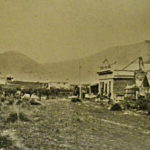Gold was discovered in the Nevis and Nokomai region on 8 September 1862 by James Lamb. Soon 1,000 hopeful miners flocked to the area. This was a year after the initial Otago Gabriel’s Gully rush that started in June 1861 and attracted over 11,000 diggers seeking their fortunes.
Conditions were tough with a climate of vigorous extremes, particularly in the higher Nevis region. Access was difficult. Miners could only take in the basic of alluvial mining equipment, not much more than a pan. Access improved when a track was put through in 1888 from Garston to the Nevis. Until then access was only by foot or packhorse.
The town of Nokomai sprung up in the lower Nokomai valley and through the mid to late 1860s, and into the 1870s, it became a boom town and one of the leading towns in Southland. In the mid-1860s Nokomai had about 20 hotels, though most would have been pretty basic. In the early 1870s there were three, each with a store attached. The Provincial and United States has survived from earlier days, whilst the Commercial operated from 1870 until 1874. The United States burnt down in 1875, when its owner purchased the Provincial and renamed it after his old hotel. It burnt down in October 1888.
In the 1860s and 1870s Nokomai was very well serviced with three grocery shops, two banks, a school, a library, and the only resident doctor between Queenstown and Invercargill. It even had its own racetrack on the south bank of the Mataura, and there was, for three or four years, a weekly newspaper called the Nokomai Herald.
The gold rush at Nokomai faded out in the 1870s when the alluvial gold had been won, and when tolerance to the climatic extremes, health hazards and uncomfortable living situations became too much, and better opportunities lay elsewhere.
But there was remaining gold which lay deep in the valley floor and which required more advanced extraction techniques. Deep mining commenced in the late 1880s once an access road had been put through allowing machinery to be transported.
Gold mining also came to the Selwood land at Parrawa. “Mining Notes” in the 16 December 1899 issue of the Mataura Ensign carried this report: “Prospecting on Mrs Selwood’s farm at Parrawa, which skirts the Mataura River, has proceeded vigorously for some time past. The prospecting has been accomplished with boring rods up to the present, and, at a depth of 20 feet, the results have been mostly encouraging. Before a dredge is put on the property, however, a further test will be made by sinking shafts.”
Even the Selwood children, either directly or indirectly, entered the Nokomai mining venture. The Nokomai Valley was only 10 km away, through the Nokomai Gorge where the Mataura River channeled its way to the east. Henry, the oldest of the Selwood children, was a small-scale miner but in 1896, at the age of 22 and with three others, applied to the Waikaia Licensing Board for 60 acres of land, leased for 21 years at Paddy’s Alley, Nokomai. They proposed to operate under the name of Stoney Creek Hydraulic Sluicing and Water Race Company, with a capital of £20,000. Sadly for them, their application was declined.
As an aside, Henry had previously been a rabbiter and had designed a new rabbit trap. To quote the Mataura Ensign of 4 December 1894: “Mr Harry Selwood, of Parawa, has brought out a new rabbit trap which ought to take the market well. Old rabbiters will at once see the benefit of this new invention. The table is protected by a casing that prevents all dirt from getting under it, so wet or fine the trap is bound to go off. The spring is a double one, and although Mr Selwood has made a lot of alterations the trap is very simple and not likely to get out of order.” There is no more information about the wider application of this rabbit trap.
Eldest Selwood daughter, Edith, was a little more successful with her association with the Nokomai mining era, albeit indirectly. In 1899 she married George Garrett who became the manager of the Nokomai Gold Mining Company. That company mined 13,250 ounces of gold on the Nokomai Flats between 1927 and 1942, using advanced sluicing and dredging techniques.
The Chinese were treated as outcasts and second class citizens by many of the Europeans, and by the New Zealand government with a poll tax levied against them. But they were hard workers and were welcomed by most in the local farming community. There is a story that the last surviving Chinese miner in Otago was Gun Too Choie. He worked at the Nokomai Hydraulic Sluicing Company in the 1920s, crushing rocks. “His weekly wage was 3 pounds. Days off were spent playing cards and Mah-Jong at the Parawa Hotel. He later became a market gardener at Outrum.” (John Gordon reminiscences).
A comprehensive review of mining in the Nokomais in 1897 can be found in the Mataura Ensign 20 May 1897 (see Papers Past). The article starts: “Possibly the best starting point for a tour of the Nokomai goldfields is Parrawa. Many advantages are contained in this arrangement. First, the visitor may depend upon receiving the greatest possible attention at the hands of Host Selwood, of the Junction Hotel, at which hostelry, in addition to ‘all the comforts of home’, there may be found a well-equipped stable, from which a steed of Arabic sprightliness or ‘Dobbinic’ reliability may be obtained; and secondly, the distance to one’s destination is a comfortable one; Mr Selwood’s house of call being situated only some six miles from the old township and nine miles distant from the Sew How claim.”






